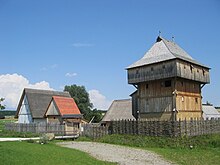Kepertuanan tanah di Eropah zaman Pertengahan
Masyarakat-masyarakat petani feudal Eropah selain United Kingdom sepanjang zaman Pertengahan sejak kerajaan Charlemagne[1] menjalinkan hubungan kesetiaan dengan suatu pihak perseorangan dari kalangan bangsawan atau borjuis[nota 1] yang berlaku tuan ke atas tanah diduduki.[2][3] Ia menggantikan sistem perladangan desa Rumawi (villa) yang sedia ada.[4] Ia lama-lama digantikan oleh ekonomi pasar berasaskan wang serta pertanian berkontrak.

Penanggungan milik tanah ini dibahagikan kepada:[5]
- tatamilik sesebidang tanah sebagai suatu estet besar (seigneurie foncière "kepertuanan tanah")
- pelaksanaan hak kurniaan dan undang-undang yang dikenakan ke atas para penduduk tanah ditumpang (seigneurie banale "kepertuanan orang kebanyakan")
Kawasan yang diaturkan dalam pemilikan tanah ini dibahagikan kepada tanah pegangan penuh atau diperintah langsung (domaine) dan tanah naungan sememata (fief, mouvance). Tanah pegangan penuh itu sendiri boleh dibesarkan secara penjualan atau pemajakan kepada penduduk tanah naungan.[6]
Nota
sunting- ^ tuan ini dalam Perancis: seigneur, Portugis: senhor, Sepanyol: señor, bahasa Inggeris: lord of the manor
Rujukan
sunting- ^ Bonnassie, Pierre (1981). Les Cinquante mots-clés de l'histoire médiévale. Toulouse: Privat. m/s. 180–4.
- ^ "Feudal Society", in its modern sense was coined in Marc Bloch's 1939–40 books of the same name. Bloch (Feudal Society tr. L.A. Masnyon, 1965, vol. II p. 442) emphasised the distinction between economic manorialism which preceded feudalism and survived it, and political and social feudalism, or seigneurialism.
- ^ North, Douglass C.; Thomas, Robert Paul (1971). "The Rise and Fall of the Manorial System: A Theoretical Model". The Journal of Economic History. 31 (4): 777–803. doi:10.1017/S0022050700074623. ISSN 0022-0507. JSTOR 2117209.
- ^ Peter Sarris, "The Origins of the Manorial Economy: New Insights from Late Antiquity", The English Historical Review 119 (April 2004:279–311).
- ^ "Guerriers et paysans. VIIe – XIIe siècle, premier essor de l'économie européenne" (dalam bahasa Perancis). Féodalité (1973). Paris: Gallimard. m/s. 168-176.
- ^ Baschet, Jérôme (2006). La Civilisation féodale: De l'an mil à la colonisation de l'Amérique (dalam bahasa Perancis). Paris: Flammarion. m/s. 178. ISBN 2081223910.
- Bloch, Marc (1989). Feudal Society (ed. 2). Routledge.
- Vol 1: The Growth and Ties of Dependence. ISBN 0-415-03916-9.
- Vol 2: Social Classes and Political Organisation. ISBN 0-415-03918-5.
- Boissonnade, Prosper; Eileen Power; Lynn White (1964). Life and work in medieval Europe : the evolution of medieval economy from the fifth to the fifteenth century. Harper torchbook, 1141. New York, NY: Harper & Row.
- Pirenne, Henri (1937). Economic and Social History of Medieval Europe. Harcourt Brace & Company. ISBN 0-15-627533-3.
Pautan luar
sunting- The Register of Feudal Lords and Barons of The United Kingdom of Great Britain and Northern Ireland Diarkibkan 2022-01-22 di Wayback Machine
- Archibald R. Lewis, The Development of Southern French and Catalan Society, 718–1050
- Estonian Manors Portal – the English version gives the overview of 438 best preserved historical manors in Estonia
- Medieval manors and their records Specific to the British Isles.
| Wikimedia Commons mempunyai media berkaitan Kepertuanan tanah di Eropah zaman Pertengahan |